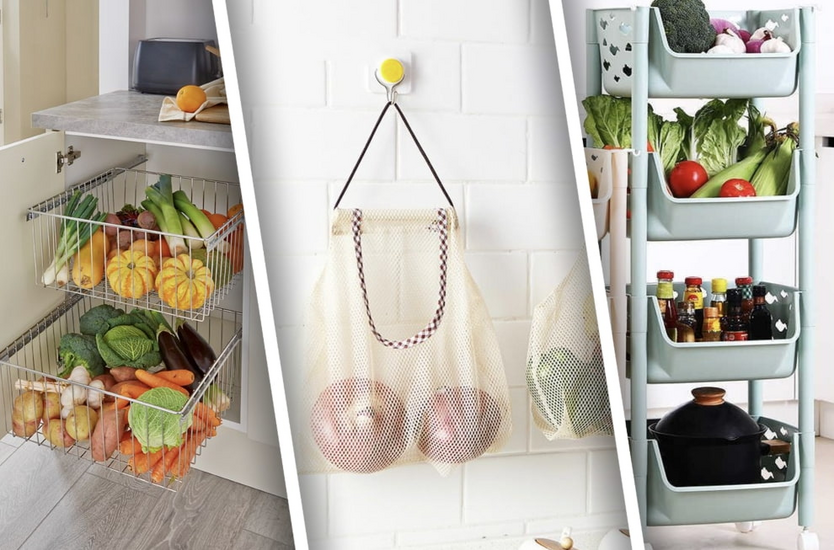How to best store vegetables in the refrigerator and in the apartment.


Storing vegetables and fruits can be a real challenge, even when it comes to storing in the refrigerator. If we talk about regular storage, the problems can be even greater. The nuances of how to store vegetables correctly can simplify the whole process both at home and in the apartment. It is necessary for everyone to do it correctly.
The question of how to properly store vegetables in an apartment can be relevant at any Time of the year, especially in conditions of constant power outages. Most vegetables and fruits will have to be stored in the kitchen (whole and sliced vegetables).
How to properly store vegetables in the refrigerator?
Starting with how to store vegetables at home, it is easier if we are talking about the refrigerator. Without a refrigerator, it is more difficult to do it, or rather it can be done "the old way". In general, how well and how long this can be done depends on the vegetables or fruits. Some vegetables actually keep better without a refrigerator, which also needs to be taken into account.
How to store vegetables in the kitchen (in the refrigerator):
Leafy vegetables (lettuce, spinach, cabbage, parsley): wrap them in a damp paper towel and place in a plastic bag or container. Keep them in the vegetable compartment. Why this helps is because the damp towel helps preserve freshness, and the bag prevents moisture loss and wilting.
Root vegetables (carrot, beetroot, radish). How to store: place in plastic bags or containers and keep in the vegetable compartment. Plastic bags prevent moisture loss, keeping root vegetables fresh and crispy.
Tomatoes. How to store: tomatoes are best stored at room temperature, but if they are very ripe, you can put them in the fridge for a short period. The thing is, storing in the refrigerator can change the texture and taste of tomatoes.
Peppers, cucumbers, zucchinis. How to store: keep them in plastic bags or containers in the vegetable compartment. Bags prevent moisture loss and keep vegetables fresh.
Broccoli, cauliflower. Wrap in a damp paper towel and place in a plastic bag or container. The damp towel helps preserve freshness, and the bag prevents moisture loss, and this is a proven effect.
Special attention should be paid to vegetables, like fruits, that are already sliced. They have different storage methods. For example, leafy vegetables. It is better to rinse them, wrap them in a damp paper towel, and place in a plastic bag or container. This way helps to preserve freshness and prevent wilting. In principle, the same procedure can be done with fresh leaves.
Solid vegetables, like root vegetables, if they are already sliced, they should be placed in a container immediately. This prevents moisture loss and oxidation. However, this process can only be stopped for a short while.
Sliced tomatoes or cucumbers should be stored in airtight containers or alternatively they can be vacuum packed. This prevents moisture loss and keeps them fresh. As for broccoli or cauliflower, it is better to wrap them in a towel (previously moistened). After that, it is better to place them in a container. This reduces moisture loss, so the vegetables will last longer.
Vegetable storage in the apartment
Not all vegetables are stored in the refrigerator, and there are many reasons for that. For example, frequent power outages and a poorly functioning refrigerator. How to store whole vegetables:
Bulbs (onion, garlic). How to store: store in a dry, cool, and dark place, in woven baskets or mesh for good ventilation. Onions and garlic need good ventilation to prevent mold and spoilage.
Potatoes. How to store: store in a dry, cool, and dark place, in paper bags or wooden boxes. This prevents sprouting and keeps potatoes fresh.
Pumpkin and zucchinis. How to store: store in a cool and dry place, preferably on a rack to prevent contact with the ground. This method helps preserve freshness and prevents spoilage.
Tomatoes. How to store: store at room temperature, away from direct sunlight. Tomatoes continue to ripen at room temperature, preserving their taste and texture.
Sliced vegetables are stored without a refrigerator for a shorter time. For onions or potatoes, the storage period outside the refrigerator can be 1-2 days. If you stop moisture loss and oxidation process (in the refrigerator and in a container), the period is extended for a couple of days. A similar situation with pepper and tomato.
In general, storing vegetables and fruits without a refrigerator requires consideration of their characteristics and environmental conditions. It is important to provide the right conditions to keep the products fresh for as long as possible.
General tips for storing vegetables and fruits without a refrigerator:
Temperature and humidity. The ideal temperature for most vegetables and fruits is between 10°C and 15°C. Avoid direct sunlight. The humidity level should be moderate. Too high humidity can lead to rotting, while too low can lead to product drying out.
Ventilation. Ensure good ventilation to prevent condensation buildup and mold growth. Use mesh baskets, wooden boxes, or paper bags.
Isolation from each other. Some fruits and vegetables produce ethylene, which can accelerate ripening and rotting of neighboring products. Keep such products separate.
Carrots or beets are best kept in a dark, cool place. They can be stored in a box with sand to prevent drying out. Sand helps maintain the optimal humidity level.
General tips on prolonging vegetable storage
In addition to proper storage, there are other ways to extend the life of vegetables at home. For example, constantly check the freshness of the vegetables. Remove any spoiled vegetables to prevent the spread of rot to other vegetables.
Extra paper towels can help. Moist paper towels can help keep vegetables fresh by maintaining the necessary level of moisture. It is also better to avoid storing in plastic without ventilation. Plastic bags without ventilation can cause condensation buildup, leading to rotting.
Proper vegetable storage helps preserve their taste, texture, and nutritional properties for the longest possible time. By using these tips, you can significantly extend the freshness of your products.
A few words on fruit storage
Fruits, like vegetables, can be stored in the refrigerator or simply in the kitchen (for example, apples). It is better to store pears in a cool, dark place, preferably in one layer. Each apple or pear can be wrapped in paper. This helps prevent damage and slows down the ripening process.
Citrus fruits (oranges, lemons, limes) are best stored at room temperature away from direct sunlight. In general, citrus fruits store well at room temperature and do not require special conditions.
Bananas are stored at room temperature away from other fruits. Bananas emit a lot of ethylene, which accelerates the ripening of other fruits. Grapes should also be stored in a cool, dry place, can be hung on a string or laid on paper. It is important to provide ventilation to prevent mold and rot.
The same applies to peaches and nectarines. Store at room temperature until ripe, then they can be stored in a cool place. The thing is, these fruits continue to ripen at room temperature.
Read also
- Up to +40 °C — forecasters warned where it will feel like a frying pan tomorrow
- Children in Odesa Region Sickened with Scarlet Fever - What You Need to Know
- Leading people into a stupor — a question that even Freud feared
- The NSSU announced an expansion of the 'Affordable Medicines' program
- Wisdom that saves the psyche — effective advice from our grandmothers
- Change Your Body in a Month — Five Useful Morning Rituals









